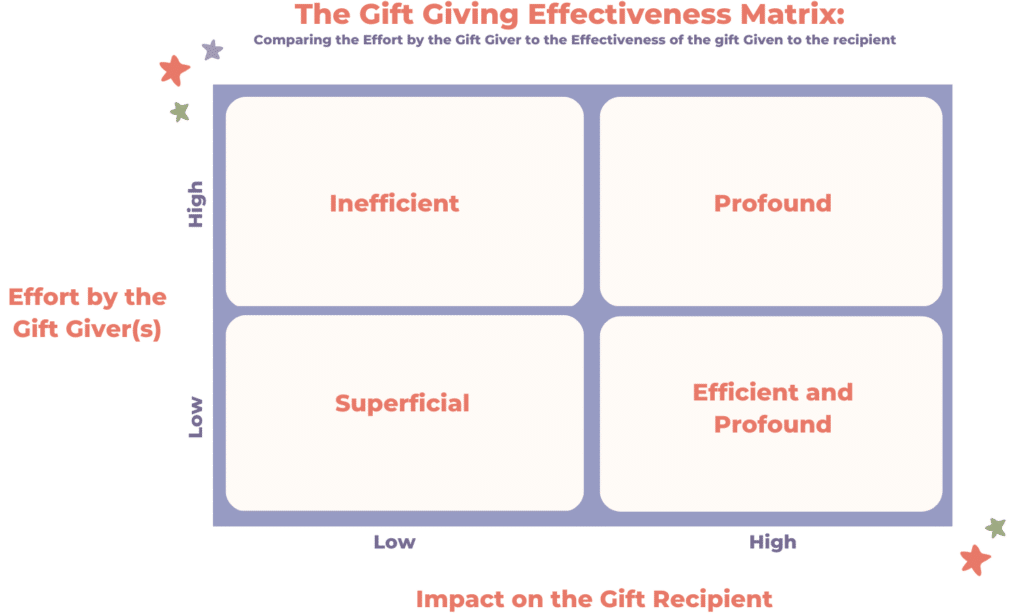You are in the right place if you’re looking for the best alternative gift to the traditional approach.
We at The Appreciation Company see the world through a different lens. We see ourselves as a step apart from the big-box, commercialized, Amazon Prime world of gifting.
You bet we rely on, and often thrive on, easy-to-obtain items for daily living, including gifts. However, we take a different approach when striving for a cut above.
Keep reading for that alternative take on gifting.
You’ll walk away with new thoughts and a practical path forward in your quest for the best alternative gift.
Table of Contents
Intro to Our Perspective on Alternative Gift Giving
Key Question #1: How Well do You Know the Person
The Science Behind Gift Giving
Key Question #2: Is the Gift Responsibility Yours or Does it Include Others?
Key Question #3: How do You Select the Perfect Alternative Gift?
Intro Our Approach Alternative Gift Giving
Since our founding, we have honed some incredible resources.
These have been shaped by seeing the world not from the commercial, monetary, trendy, or ‘easy’ view of gifts but from the perspective of what makes a gift meaningful.
Also, getting the right gift is a lot of emotional, time, and financial work. We don’t want that work to be wasted.
Quite the opposite. we seek the best alternative gift for you, the gift-giver, and have it achieve the outcome you intend for the recipient.
These perspectives and resources, when used carefully, can grant you gifting superpowers that are effective under most circumstances for most occasions.
Key Question #1: How Well do you Know the Person?
Always start with this question.
When advising on a gift, we always ask this question to understand the context of the relationship.
We ask this even before asking about the occasion or reason for the gift.
Why?
The relationship between the giver and the recipient is the most crucial factor in whether a gift received will be great or a bomb.
How to determine how well you know the recipient
Think of the person you are about to gift for and answer ‘Yes’ or ‘No’ to these questions:
- Have you been to the person’s house?
- Do you know what is in his cupboard and refrigerator?
- Can you name what’s in his bookcase or on the coffee table?
- Do you know what’s on their bathroom surfaces?
- Do you know if they have any allergies?
- Do you know the brands in their closet or drawers?
- Do you know what is in their garage?
Context questions like these provide sharp clarity to realize how well you know a person…or don’t.
From this clarity, you can begin the process of selecting a gift.
Now, if you answered “yes” to some or all of the questions above, answer the following:
- Name 5 foods they eat regularly.
- Name 3 products in their bathroom.
- Name 4 brands they regularly wear.
- Name 7 books on their shelves.
Simply thinking about the answers to these questions will help guide your understanding of how well you know the recipient of your gift.
More importantly, this exercise reveals any blind spots or, alternatively, areas of a specific understanding of the person’s life and preferences. With this knowledge, you can focus on getting the best alternative gift.
Real-life example of relationship context
Let’s put one of my own relationships into context.
I jog with one of my closest friends three days a week. We’ve been exercising together for over 18 months.
Over the past five years, I’ve been to his house dozens of times, our kids hang out, and we’ve been to birthday parties.
I’d consider this relationship one of the highest context friend relationships I have outside of my wife and kids.
But I can’t answer most of the questions above about my friend, his personal habits, and the contents of his home.
It isn’t that I’m not paying attention. I simply can’t answer those questions with specificity.
Let’s say I’m going to get my friend a gift.
Why offer food if I don’t know what is in his fridge or cupboards? If I don’t know about his bookcase or coffee table, could books or home decor be risky?
I do know he needs a new pair of running shoes, and he occasionally misplaces his gloves. So, this narrows my scope of context for what gift category I should prioritize.
At this point, some people get a pit in their stomach.
This is because a realization slowly dawns on them that there are whole categories of gifts where they don’t know the person well enough to get the gift.
If you don’t know the answers to the questions above, don’t worry. There is a missing piece in the equation that needs to be unlocked.
The Science Behind Gift Giving
Here is a little behavioral science for you.
The extent to which you know an individual is called context. The more you know about a person, i.e., the more “yes” answers to questions like those above, the more context you have about that person.
Basically, the amount of context we have about a person falls along a spectrum from zero context (i.e., someone you don’t know) to full context (i.e., you know the person completely).
Regarding gifts, The Appreciation Company tends to categorize an item in terms of high and low context. We do this to simplify the discussion and ensuing approach.
High-Context v. Low-Context Relationships in Alternative Gift Giving
High-context gifts require you to know the person well to know if the gift will be effective.
If you have a high-context relationship, you can and probably should get the person a gift where you can employ a high-context gift strategy.
In contrast, if you have a low-context relationship, there are categories of items to avoid. This will reduce the possibility of offering a lousy gift.
For example, suppose you are entering a category where you lack knowledge of personal details (i.e., context). In that case, you are increasing the risk that your gift won’t be well received.
Here’s the good news. If the recipient knows you don’t your relationship doesn’t have much context, they won’t expect a high-context gift.
High-context relationships are typically family members you live with. Also, your closest 3 to 5 friends, a parent, or someone you’ve been dating for a while are likely high-context. Gifts for high-context relationships include food, clothing, personal care, and home decor.
On the other hand, relatives like aunts, uncles, and cousins are typically lower context. Lower still, generally speaking, are people from work or church and your kid’s teacher or coach.
A special case: Are you giving to an individual or a group of people?
It is common to be on the hunt for a gift for a group of people. If this is your case, here are some alternative context questions for you:
- Is everyone the same gender?
- Is the group size five people or less?
- Do they share a common interest?
Did you answer “yes” for any of these questions? Then a single high-context gift could be the right fit.
If you answered “no” to some of the questions, then the context approach is straightforward. Assume a position of low context and only offers low-context gifts.
For example, for a group that loves high-quality cooking from scratch, a bottle of the world’s most extraordinary organic vanilla extract might do the trick. Something like Lagrima’s vanilla is universal enough, yet strangely specific, to appear high-context without actually being so.
If you don’t know the person that well (low-context), you can be free of the obligation implied by a high-context gift.
Key Question #2: Are You Gifting to One Person or a Group?
We ask this question to understand if you are the sole decision maker in the gift or are acting as facilitator or champion of a group gift.
If you are playing that role for a group gift, we created a fantastic guide that puts you in the driver’s seat of facilitator. It also helps take the emotion out what coming up with “the best gift” or “how are we going to decide?”
We want the following for you and your group:
- First, for everyone to get along and be strengthened by the process. The last thing we want is to hurt feelings and diminish the experience for anyone.
- Second, we want the recipient to know and feel the impact of the gift. This is what it’s all about, right?
This incredibly effective resource considers your effort (time and money) with the impact you want to land with the recipient.
Much like the high and low context relationship example above, we take this a step further to consider high-effort and low-effort as well as high-impact and low-impact.
Most people we work with, across most occasions, are seeking low-effort yet high-impact gifts. That is the sweet spot of gifting.
Introducing The Gift Giving Effectiveness Matrix

Gift options you are considering can be classified as either high- or low-effort (on the giver’s side) and high- or low-impact (on the recipient side).
Here’s how the scoring in the matrix breaks down:
- Inefficient (high effort x low effectiveness): Given the effort or cost, the gift doesn’t achieve the intended impact. For example, custom items, something out of context, or items in poor taste, given the recipient’s circumstances.
- Superficial (low effort x low effectiveness): Likely both the gift giver and recipient know this is a superficial gift. Examples include coffee mugs for someone with plenty of mugs, a candle, or a trinket.
- Profound (high effort x high effectiveness): Gifts that profoundly impact the recipient. Likely the giver knows the recipient well, and the context is appropriate. Examples include hand-made items or ones that are expensive and relevant. Profound gifts are one-time gifts specific to the individual.
- Profound and Efficient (low effort x high effectiveness): This could be a sweet spot for gift giving in a busy world or on a budget. Ideally, these items are scalable for groups of recipients, such as all the teachers at a school or coaches in a league. Examples include gift cards, cash, and personal notes of appreciation.
Download our free Gift Giving Effectiveness Matrix and walk through the simple exercise. It can be done as a solo or group activity.
Question #3: How Do You Select The Best Alternative Gift
If you seek the best alternative gift for someone, there is a risk that the gift will fall short of your intended impact.
To minimize this risk and land a great gift, start by understanding the recipient. Specifically, if you have a high context for a specific gift category, start there.
Major categories of gifts align with areas of a person’s life or the way our homes are structured:
- Food
- Personal/beauty care
- Clothing and apparel
- Decor
- Experiences
Then there are ways to niche these categories, including
- Specific activity
- Eco/organic
- Color, taste, smell
- Digital vs. physical
- Customized/personalized
If the gift comes from a group, find a fun and constructive way to hear everyone’s suggestions and ideas so that the approach includes diverging perspectives.
Our gift planning resource built from the Gift Giving Effectiveness Matrix is helpful for group discussions.
Finally, suppose the gift recipient is a group of people. In that case, it is okay to offer a low-context gift that guarantees universal acceptance and positive impact.
The Appreciation Company was founded around this last point. Our research shows that teachers, coaches, and basically everyone in a group setting desire two things:
- To know they are appreciated, and their work has a purpose through an impact made in someone’s life. A written note is the best way to do that.
- The cash equivalent, in the form of a gift balance, allows them to choose the item they most need and want.
The point is the card is what really matters. The monetary amount is secondary.

Free Download
Rebekah’s structured way of picking the perfect gift
Whether the gift is from you or a group, I’ve found this is a rational way to arrive at the perfect gift. One that is both effective for the recipient and matches my budget and time. I hope it makes your life easier. By signing up, we’ll stay in touch via email.



